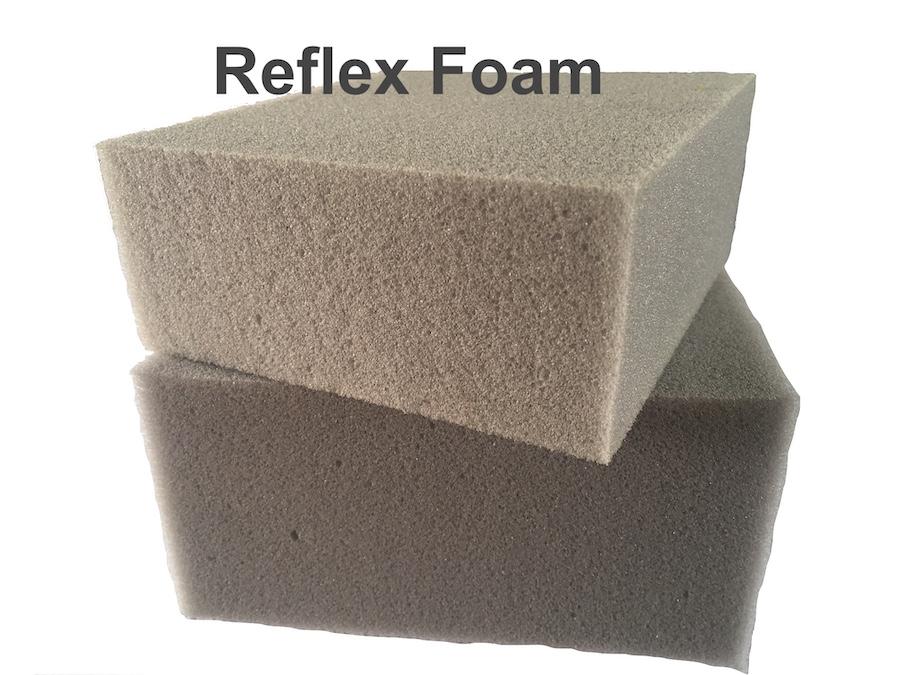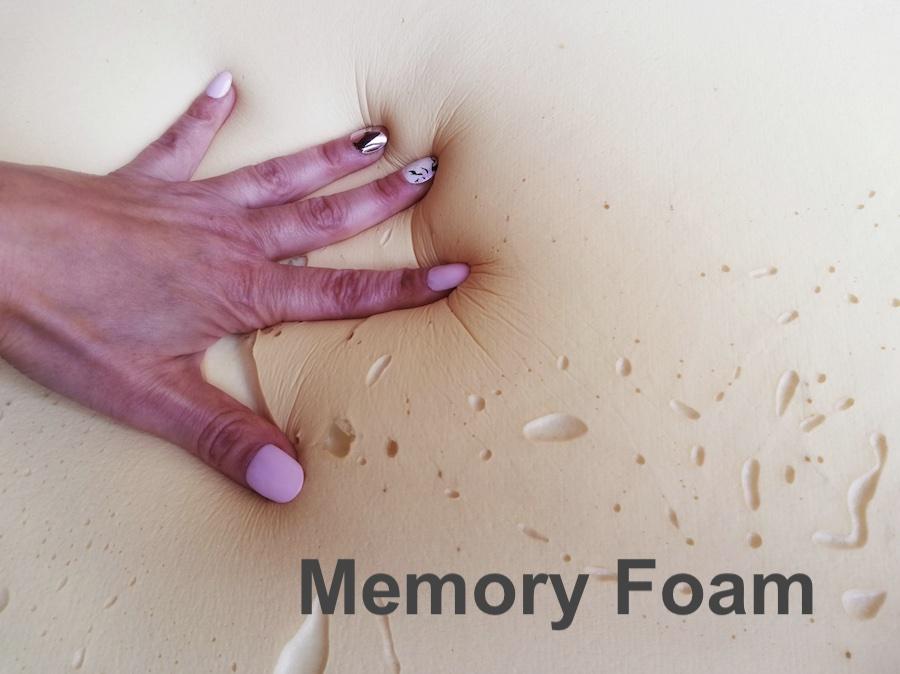With so many variations in foam available, it can be difficult to discern between them to get the foam for the right product or project. One comparison often made is Reflex Foam vs Memory Foam.
So here I’m looking at both Reflex and Memory foam, starting with a quick summary of Reflex foam vs memory foam…
Reflex foam could be mistaken for a more firm version of memory foam, both have similar qualities in posture support, allergy resistance, bounce-back properties, and lifespan. Reflex foam is often used for more orthopedic applications, while memory foam offers softer comfort and more warmth.
With that summary in mind, let’s get straight into the direct comparison, then we’ll move on to what advantages each one brings that you should also take into account…
Memory foam vs Reflex foam
Reflex foam and memory foam are based around the same kind of ingredients and processing. However, nuances in the manufacturing process, designed to alter viscosity levels, changes how each one feels and behaves quite dramatically.
Below I’ve outlined some of the main differences between the two.
Structure
Both Reflex foam and memory foam are open-cell foams, so are made up of tiny holes. The difference is memory foam expels air quickly. Reflex foam, due to its extra-firm structure expels less air, retaining “pockets” of air within the structure, any air that is expelled or absorbed happens faster.
Feel
Both Reflex and Memory foam feel different. Reflex foam is on the firm side of the spectrum while memory foam is on the softer side. Reflex foam is ideal for people who do not want to feel the heat in their mattress, while memory foam is ideal for those who like a cozy, warm sleeping environment.
Cost
In reflex foam vs memory foam, reflex foam is much cheaper in cost than memory foam. But most mattresses will have a memory foam top layer and often a reflex foam layer beneath that, so you will often be paying for a combination of the two.
Similarities
Even though the two have major differences, you could be forgiven thinking that memory foam and reflex foam are the same, in some ways, reflex foam might feel like a more firm version of memory foam.
Both these foams have great durability and can last for many years if properly taken care of. Both foams bounce right back into their original shape after pressure is released off of them. Although memory foam perhaps a little slower than reflex foam.
They both offer body contouring and bounce-back abilities, making them ideal for extensive and regular use – without the fear of having to replace them after just a few years.
Another similarity between the two is their collective medical benefits such as pressure relief, back, and neck support, avoidance of allergies. Mainly because both use naturally resistant materials towards mold, mildew, dust mites, and bed bugs.
Here’s a table showing key comparisons between both Reflex foam vs Memory foam…
| Factor | Reflex Foam | Memory Foam |
|---|---|---|
| Common Use | Low-Mid Mattress Layer Orthopedic Use | Upper Mattress Layer Mattress Toppers |
| Comfort | More firm | More soft |
| Motion Transfer | Low | Very Low |
| Durability | Very High | High |
| Lifespan | 8-10 Years | 8-10 Years |
| Posture Level | Orthopedic | Excellent |
| Heat Retention | Medium | High |
| Cost | Lower Cost | Higher Cost |
Now let’s look at each in a little more detail in our comparison of reflex foam vs memory foam, by looking at the advantages that each brings. Some of which I have already mentioned in the comparison above.
What is a Reflex foam?
Reflex Foam is a brand name given to a blend of polyurethane foam manufactured by British Vita. It is a supportive, responsive, and high-density foam often used in the mid to upper layers of mattresses. It offers greater support as it adapts well to the body shape.
Polyurethane is a blanket term given to a number of different types of foam blends. You can read more about Polyurethane foam here.
Reflex Foam is a specific blend of polyurethane foam, which means at the time of manufacturing it is chemically and process adjusted to create a particular density. In this case, this variety is considered High-Density.
Foam density and firmness are very important factors when considering foam, so I’d recommend you read my article on density and firmness.
Due to the foam being on the firmer side of the density spectrum, it is more commonly used in the base and transitionary layer of a foam mattress, so it’s rarely found at the very surface.
However, due to its orthopedic benefits such as aiding in spinal alignment, and posture support, there are manufactures that make mattresses almost completely out of reflex foam.
Reflex foam has good orthopedic properties because of the make-up of very small holes that offer just the right density to adjust to a person’s body shape.
It’s able to provide this support while maintaining bouncebackability. It just happens that this particular and popular formula was named ‘reflex’ foam.
You can read in more detail about Reflex foam here. Or, if you’re comparing lots of foam options, then check my easy list of Types of Foam here to get a good overview of each, along with their common uses.

Advantages of a Reflex foam
Let’s go through the advantages of reflex foam…
Reflex promotes and supports good posture
Reflex foam offers great body weight support to most body types and shapes since it is one of the firmer foams on the market.
This is especially helpful for people with orthopedic challenges such as back pain. It can help in keeping your spine aligned. Moreover, reflex mattresses are also hypoallergenic and antibacterial.
Reflex foam retains less heat
Due to reflex foam’s cellular structure, you can avoid the uncomfortable feeling of being too hot or “stifled” during the night.
Although Reflex foam does have high heat retention, it is not as high as memory foam. This feature can help you get a good night’s sleep, and therefore help you to feel fresher in the morning.
Reflex is infestation resistant
Bed bugs and dust mites can be a source of irritations as well as an inconvenience but a reflex foam can help solve this issue.
Similar to Dry Fast foam, Reflex foams are manufactured with resistance to bedbugs and dust mites, providing you with a cleaner and healthier environment to rest and sleep in.
Reflex foam is durable
Reflex foam has the ability to contour to a person’s body shape …but has enough spring to bounce back when not under pressure.
This feature of reflex foam makes it last that much longer – while still feeling comfortable.
Typically, reflex mattresses can last anywhere from 8 to 10 years.
What is memory foam?
Polyurethane is a polymer that is made as a byproduct of petroleum refining. Memory foam is a blend of polyurethane and other chemicals.
Memory foam was first introduced in the ’70s as pilot cushioning by NASA but has since then progressed to become one of the most popularly used materials in mattresses, pillows, and similar products. Memory foam allows for it to contour to different body types while maintaining its shape.
When any weight is lifted, memory foam eases back to its original shape.
However, even though this foam is popularly used worldwide for its utmost comfort, you should keep in mind that memory foam has a tendency to off-gas and to sag after a shorter period of time than reflex foam.
So, when purchasing memory foam, proper research needs to be done regarding the various types available to make sure you buy what fits your needs the most.
You can read more about memory foam here.

Advantages of memory foam
Let’s get into the advantages that memory foam brings…
Memory foam is highly comfortable
Memory foam is designed to react to a person’s body heat and temperature and adjust according to it.
This feature helps the foam contour to a person’s body shape, resulting in a high level of comfort – along with appropriate body support throughout.
Its highly resilient material and its body-sensitive features are what sets it apart from other conventional foams.
Memory foam is durable
If you’re looking for an investment worth making, then memory foam should be on your list.
Since this material is highly resilient and although it can gradually lose its shape over a period of time with extensive use, with proper care and maintenance it can last a long time.
Typically, Memory foam can last around 8-10 years.
Medical benefits of memory foam
Memory foam is highly recommended for use if a person is suffering from chronic neck and back pain as this foam distributes the weight and offers appropriate support to the whole body …without compromising on comfort.
Its natural resistance towards dust mites, mold, and mildew is also a plus point for people with allergies.
Memory foam absorbs motion
Sleeping with a partner that moves a lot in the night, especially on a bouncy bed can lead to a poor night’s sleep.
Memory foam copes with motion transfer very well. Memory foam absorbs the energy and movements from motion in other areas so that if one side of the mattress is subjected to movement, the other side remains largely undisturbed.
To finish then…
I hope this has given you a good overview of Reflex foam vs Memory foam. If you’re exploring different types of foam for your project, then you can get a great overview of the varieties of foam in my Types of foam article.

